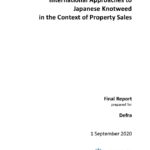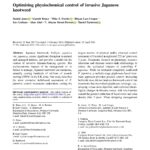Japanese knotweed
Fallopia japonica
Overview
Photo Credit: ©CABI/Richard H. Shaw
Fallopia japonica
Habitat:
Origin and Distribution:
Impacts:
How did it get here?
Is it found in Northern Ireland?
Advice for commercial property and homeowners
Legislation: (Northern Ireland only)
Further Resources: For further queries, you can contact the Invasive Non Native Species (INNS) Team in the Northern Ireland Environment Agency on 028 9056 9558 or Email: invasivespecies@daera-ni.gov.uk
Fallopia japonica
Habitat:
- It inhabits a wide range of conditions, including full shade, high temperatures, high salinity and drought. It is found near water sources, such as along river banks, low-lying and disturbed areas. It can colonise coastal shores and islands
Description:
- This is a relatively large plant that can grow up to 2 – 3 m in height and can dominate an area to the exclusion of most other plants. It can form an extensive network of rhizomes (roots) which cause problems when managing this species. Small pieces of rhizomes are capable of rejuvenating the plant. The rhizomes also allow the plant to survive over winter when the over ground conspicuous leafy part of the plant dies back to a brown wasted stem.The leaves are shield or heart shaped usually with a pale stripe down the middle. Flowers are creamy and arise from the tips of stems. Some useful resources to download;
Origin and Distribution:
- A native of Japan, Korea, Taiwan and China where both male and female plants are known
- This species is now widespread in continental Europe, Britain and Northern Ireland
Impacts:
- F. japonica is a threat in open and riparian areas where it spreads rapidly to form dense stands, excluding native vegetation and prohibiting regeneration. This reduces species diversity and alters habitat for wildlife. Once stands become established, they are extremely persistent and difficult to remove
- Japanese knotweed is also of concern to developers and private citizens. This plant has the ability to grow through tarmac and concrete, although only if a weakness already exists and therefore must be cleared completely before starting to build or lay roads
How did it get here?
- The date of first introduction to Ireland is not know for certain. It is believed that this plant arrived in the mid to late 1800’s. Regardless of the date of introduction, this plant has spread from gardens into the environment and is now a pest species.
Is it found in Northern Ireland?
- It is present and widespread in Northern Ireland. More distribution information can be found at NBN Atlas NI.
- You can help by reporting any sightings: @ the Centre for Environmental Data & Recording (CEDaR) - Or via the iRecord App
Advice for commercial property and homeowners
- Homeowners can consult the Property Care Association.
- They have produced some good guidance documents such as their Code of Practice for the Management of Japanese knotweed and Japanese knotweed – A guide to the problems caused and how to deal with them
It includes such advice as Some Do's and Don'ts;
-
- Do make a start straightaway to deal with Japanese knotweed growing on your property. The longer you leave dealing with it, the more Japanese knotweed there will be to deal with!
- Don’t just cut the plant down and try to cover it up. Apart from being highly irresponsible, the problem could come back to haunt you when the plant regrows
-
- Don’t strim, cut, flail or chip knotweed plant parts as tiny fragments can regenerate new growth
- Don’t cut down and/or dig up the plant and put it in the local authority compost collection. This would be breaking the law and Japanese knotweed rhizome is not necessarily killed by the composting process, part of which is to break up the material into small fragments, thereby potentially exacerbating the risk of spread
- Don’t contact National Parks & Wildlife Services or the Northern Ireland Environment Agency to provide advice on your specific situation or to recommend a suitable contractor. They are not able to advise on each and every case and are restricted from recommending contractors
- Do visit the PCA’s web pages (www.property-care.org) or call the PCA (0844 375 4301) to seek advice
- The PCA have also produced some very useful videos;
- N.B. All PCA documents are Copyright © Property Care Association. All rights reserved. We would respectfully ask that these documents are used with the understanding that they are not for sale or distribution by third parties and should not be copied or redistributed without the express permission of the Chief Executive Officer of the Property Care Association.
Legislation: (Northern Ireland only)
- Under article 15 of the Wildlife (Northern Ireland) Order 1985, it is an offence to plant or otherwise cause to grow in the wild Japanese knotweed or any other invasive plant listed in Part II of schedule 9 to that Order
- There is no legal obligation to remove Japanese Knotweed from your land or report it to regulators, however the presence of the weed may result in civil liabilities
- Nor does the Wildlife (NI) Order 1985 include offences for the natural spread of an invasive species from one area to another
- But there is perhaps a community expectation within society that owners of property and land look after such assets responsibly
- At present, there is no statutory mechanism (by any statutory body) to compel an owner or an occupier of premises or land to control Japanese knotweed or to permit others to carry out control measures without an owner or occupier’s consent
- Where species such as Japanese knotweed are spreading from one private property to another it constitutes a civil matter between the two landowners
- It is important to highlight that, in both national and EU legislation, DAERA's primary policy context towards all non - native invasive species is one to assist protect the ecology of an area
- Homeowners should seek advice from organisations such as the Property Care Association who have the relevant expertise to advise on such civil cases
- A landowner would only be guilty of an offence if they were to remove the knotweed from the site in an inappropriate way, in other words not using properly licensed hauliers and landfill facilities, but that would be an offence under waste legislation not wildlife
- If a landowner is disposing of knotweed, or any other 'controlled waste', by cuttings or by excavation The Waste and Contaminated Land (Northern Ireland) Order 1997 (as amended) is relevant. This legislation places a duty of care on “anyone who produces, collects, carries, keeps, treats or disposes of controlled waste to take all the necessary steps to keep it safe and to prevent it from causing harm, especially to the environment or to human health
- If a member of the public were to suspect an offence under the Wildlife (NI) Order 1985 was taking place, then they must call the PSNI on 101 and report it N.B. Remember this would only be relevant to an incident actually happening in the present, not an historical or anecdotal occurrence.
Japanese knotweed research:
 |
|
|
International Approaches to Japanese knotweed in the Context of Property Sales |
 |
|
Optimising physiochemical control of invasive Japanese knotweed |
 |
|
Japanese knotweed (Fallopia japonica): an analysis of capacity to cause structural damage (compared to other plants) and typical rhizome extension |
 |
Further Resources: For further queries, you can contact the Invasive Non Native Species (INNS) Team in the Northern Ireland Environment Agency on 028 9056 9558 or Email: invasivespecies@daera-ni.gov.uk

